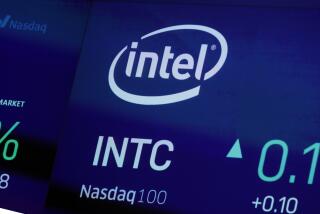Intel’s Accord With EPA Raises Concerns Over Regulation of Hazardous Emissions
SAN FRANCISCO — The semiconductor industry makes 220 billion chips a year. It uses hundreds of millions of gallons of water and produces tons of toxic gases and hazardous solid and chemical wastes each day.
As a result, Silicon Valley has more hazardous waste sites--28--eligible for federal cleanup funding “than any comparable area in the United States,” according to the Environmental Protection Agency.
Through the years, toxins in the air within semiconductor fabrication plants at several companies were linked to exceptionally high miscarriage rates, and workplace toxins are also at the core of allegations in a lawsuit brought this year by cancer patients who worked at a New York state chip maker.
With the industry’s record as a backdrop, an agreement reached last week between Intel Corp. and the EPA--which gives Intel more autonomy on how it controls and monitors hazardous emissions from its Chandler, Ariz., chip-making facility--has led some to worry about future regulation of the industry.
Though the specific Intel agreement was praised for a number of reasons, such as Intel’s agreement to recycle 65% of the fresh water it uses and to cap overall emissions below current EPA limits, some people fear less favorable pacts will follow.
The EPA and Intel deal is a pilot project that, if successful, will become a model for environmental regulation in the semiconductor industry.
“We are very concerned about it. We think the community accountability provisions are very weak--giving up EPA oversight. We are concerned it will become precedent that others will follow,” said Ted Smith, president of the Campaign for Responsible Technology and the Silicon Valley Toxics Coalition.
“Historically, this industry has been given one special treatment after another by the government, basically because the new industry of microelectronics is so important,” said Dr. Joseph LaDou, director of occupational and environmental medicine at the University of California at San Francisco Medical School.
LaDou has treated hundreds of patients burned by hydraflouride and other chemicals used in semiconductor plants.
Semiconductor chips, the tiny brains behind all manner of computerized equipment, are made in an intricate layering process involving dozens of chemicals. Production is done in a sterile, dustless area called a “clean room” in which the air circulates about 20 times an hour.
Some critics argue that while no one chemical typically used in semiconductor manufacturing is used in high enough concentrations to be dangerous, the accumulated array of chemicals and vapors in fast-moving air is harmful.
The National Resources Defense Council believes Intel gets too much leeway in determining emission levels of individual wastes.
Furthermore, technology advances bring changes to the semiconductor manufacturing process about every two years, potentially rendering environmental standards obsolete.
The industry has corrected some of its more grievous environmental misdeeds.
For instance, manufacturers have stopped using the underground storage tanks that leaked and caused the Superfund sites, and most of those sites are being cleaned up. Also, most manufacturers have stopped using ozone-depleting chlorofluorocarbons.






